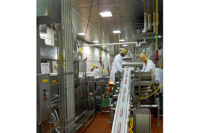The U.S. Department of Energy (DOE) has projected electricity use to increase by 33 percent between now and 2030. The most rapid growth area will be the commercial sector - electricity use in the industrial sector alone is projected to grow by 22 percent.
By reducing overall customer loads by just one or two percent, utilities can avoid buying market power at peak prices. For example, PJM, a regional transmission operator, credits demand response with saving its customers $650 million in one season, $230 million in single day.
Utilities are expanding demand response programs and launching new ones.Many have struck multi-year deals with aggregators of commercial and industrial demand response, rather than sign up individual customers or seek other ways to continue to meet peak demand.
The load commitments in those aggregator contracts escalate. For example, demand response service provider EnerNOC signed a five-year capacity agreement in October 2007 with Southern California Edison. The agreement ramps up from 40 MW to 160 MW of load reduction over its term.
California is not the only state with experience in demand response. Five of the six major transmission regions in the U.S. have demand response programs in place. Utilities in New Mexico, Florida, Kentucky and California recently have implemented or expanded their use of demand response.
Limitations of demand response today
The way demand response technology typically has been implemented thus far, there are severe limits to how much benefit it can deliver.Manually responding to a demand response call restricts the scope and type of loads that can be shed. For example, certain manufacturing equipment cannot be simply turned off. Plant managers must consider work in process and follow proper procedures to take complex machinery offline without causing losses.
Scaling up demand response will not be as easy as it might seem. Utilities and aggregators naturally began by skimming the cream - enrolling the most knowledgeable, willing customers who offered the easiest loads to shed. Shedding the next, deeper layer of loads will be more challenging.
Early adopters often participate in demand response programs for reasons beyond the financial payback. The bottom-line value proposition of demand response will meet its true test as larger kilowatt reductions are pursued. Until that time, we cannot really know whether the pure financial value proposition is compelling without the help of corporate social responsibility and public relations as motivators.
By shedding just the very easiest loads, early adopters are receiving lower payments than they could be, because limiting the kilowatts available means limiting the financial potential. The resulting low payments undermine the value proposition of the programs over the long term and certainly make cost-justification more difficult for the participant using a real cost-benefit analysis.
Industrial sector
To reach the true potential of demand response, utilities must tap into resources from the largest electric end-use sector: industrial DOE projects for that to remain constant through 2030.Managing energy consumption in industry will reduce operating costs in an increasingly competitive global marketplace. In energy-intensive industries such as food, the cost of energy averages 4.8 percent of annual operating expenses. Yet, only about one in eight manufacturers uses any form of load control, and the adoption rates for demand response in the industrial sector remain very low.
A major reason for the low adoption rate is that the largest processing loads are fundamental to operations: productivity may be jeopardized when plant managers shed loads such as refrigeration and freezing systems, foundry equipment, forklift chargers and material handling systems.Processors, being understandably cautious, either limit or forbid shedding of these fundamental loads.
The next level of demand response must expand participation of fundamental loads if it is to reach its full potential. What utilities need is a way to break the fundamental load barrier.
Intelligent demand response reaches fundamental loads
The next level of demand response requires intelligence and the use of state-of-the-art demand management automation with specific functionality to overcome the limitations of manual methods. It increases the potential reward of expanded curtailment, while controlling risk to industrial customers.Automated, intelligent demand response enables participants to:
• Connect many loads, then orchestrate which subset will make up each response;
• Make response decisions quickly based on preset rules;
• Protect processes with strict load shedding rules;
• Respond to a call dynamically with rolling reductions;
• Give utilities direct control over certain loads;
• Gather data and analytics to fine-tune response and verify performance;
• And track and control the productivity impact of demand response.
Intelligent demand response is a logical evolution for managing peak demand. And it is possible with systems available today.
Industrial users already apply dedicated controls systems and application-specific products in key processes, to be more efficient or trim production costs. Now it is possible to apply dedicated demand management systems to coordinating and controlling the use of power in a manufacturing plant.
Challenges and solutions
Implementing intelligent demand response will have its challenges, not the least of which are the up-front investments and customer resistance to tapping fundamental loads.The solution is to create a quantifiable value proposition with manageable risk. Eager industrial participants are those who see the financial benefit from demand response and feel that they can keep risk under close control.
Risk management -The key to keeping risk under control is intelligent demand response technology. It gives plant managers control over which loads are shed, and it removes the risk of damage to essential equipment by correctly managing the shutdown and restart procedures for each demand response event.
The right technology also eliminates the fear of the unknown. It provides the information and analytics needed for plant managers to understand and control the productivity impact of demand response.
Equipment incentives -A major tool for increasing the adoption of automated demand response is to provide incentives to industrial customers for the purchase of the necessary equipment. When the proper equipment is in place, it is easier for the customer to make the commitment to participate.
Demand response solves what is primarily viewed as a utility problem. By providing incentives for equipment and systems, utilities invest in the solution. Incentives give companies the tools for providing predictable capacity and streamlined implementation - and that removes barriers to participation.
Utilities are aware that more participation would help to postpone the building of new power plants and reduce their purchases of high-priced wholesale power to meet peak demand. They can achieve this by investing in equipment for relatively few, but significant, industrial customers.
If it is left to the value of curtailment payments alone, then intelligent demand response will progress, but at a slower pace. Incentives are simply the catalyst to get customers to take action sooner. Speed of adoption is exactly what the emerging demand-response trend needs, to meet expectations.
Payoffs
Utilities -The reward to load-serving entities for investing in intelligent demand response is already clear. A comparatively modest investment in equipment for energy-intensive customers can produce a clear return by reducing energy costs and decelerating capital expenditures.There is a deep well of energy resources waiting to be tapped, and with it, utilities can postpone plans for new power plants and lines. Add to that the reduced purchases of wholesale power at its highest price point. A 3-percent reduction during peak hours would reduce energy market prices by $8 to $25 per megawatt-hour, according to a study conducted in 2007 encompassing five utility territories.
Customers -The same study concluded that demand response in the PJM region, for example, could save participants an estimated $9 million to $26 million on energy annually, and avoid another $73 million in capacity charges. This is in addition to the revenue stream from participating in demand response.
Utility customers get two additional benefits. First, ongoing efficiencies are achieved when intelligent demand response technologies are deployed, reducing operating costs throughout the year. Second, the avoided cost of purchasing high-priced wholesale power creates a savings that is passed on in tariffs to all utility customers, not only to those who participate in demand response.
Aggregators -With accelerating commitments to their utility customers, aggregators need to unlock the potential of demand response. Intelligent demand response is the key. It enables aggregators to enroll reluctant customers, sign up larger controllable loads, and expand existing agreements.
Bob Zak is president of Powerit Solutions LLC, based in Seattle. Powerit Solutions is a provider of intelligent energy management solutions designed to enable demand response, reduce ongoing peak energy demand and generate cost savings and energy conservation for industrial customers.
For more information, visit,www.poweritsolutions.com.


